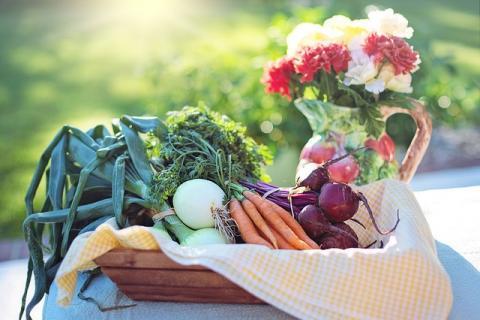
If you are trying to get healthier, inside out, the first thing you need to focus on is home-cooked meals. It's important to get organized well enough to be able to cook those healthy meals at home. Here’s some help…
As a woman with two kids, I am busy enough. Add to that a work-at-home career and a household to manage; the bane of my life is managing my weight and my health. And since I am only 5'1, the former shows if I balloon every now and then. I manage to put the healthiest I can in my kids. But my meals do get a bit haywire with work stress and an ever-present craving for junk!
Now in my 30s, I am careful to make sure that what I eat is not just fuel to keep my body going. Food has to be holistic, organic and good for me. How I do that is simple: organization. It takes a couple of hours of planning over the weekend to get through a week well eaten! So here are some of my tips – see if they can help your dining table get a little healthier, one step at a time.
- Plan A Few Main Dishes: I am a firm believer of cook once and eat twice. Which is why planning four to six main dishes will be enough for most weeks. Make sure that each of these main courses is diverse enough to be served with different sides. Make a batch enough for two meals, divide and store one in the fridge for later use. For example, have baked chicken with a soup one day and with fragrant lemon rice on the second. A chicken and veggie stir-fry can go with salad one day and with roti or rolls the next. A warming stew gets topped over wild rice or mopped up with garlic toast. You get the idea, right?
- Fix A Day: It’s useful to make your meal plan at the same day of the week. Saturday works for me because then I can do the groceries on Sunday. One step you need to do before you start making lists is to look through the kitchen, refrigerator, and the cold storage. This is to make sure nothing is on the verge of going bad. If you shop like me, you’ll often find enough ingredients to make a stew, soup or even a casserole to tide you over -- one good way to save both food and money.
- Make Your Own Recipe Book: I don’t follow recipes to the tee. I add, detract and substitute as per will and sometimes necessity too. But I don’t always remember what all went into making that recipe, especially if it was a hit and needs to be made again (or in my case, is often demanded by my epicurean husband or sons!). Now, whenever dinner is a success, I write down all that went into making that recipe one happy hit. This way, I have a ready reference guide.
- Ask For Recipes From Friends & Family: Our mothers, aunts, uncles, and even those friends who are a whiz in kitchens are awesome recipe givers. The next time you are feeling stuck, call them for help. Else scour the Internet, books, and magazines. If you try one new recipe a week, you’ll have added 52 to your repertoire by the year-end. Browse through doable recipe books. I love to go to flea markets for cheaper deals on old but classic books.
- Organize Your Recipe Folder: Classify your recipes into types so that you can see all your pasta or fish dishes at a glance. Keep the meats and the veggies separate. You can classify them as lighter weekday meals or heavier weekday indulgences too.
- Build Up A Healthy Kitchen: Sausages and hams, ready to eat curries and all white carbs do not a healthy meal make. Build up your larder and refrigerator stock of healthy standbys. Think pulses, brown rice, pasta, tomato puree, olives and fresh vegetables and fruits. Buy some herbs and exotic spices to go with that fish or chicken. All these can make the basis of a quick, simple meal to fit into your weekly meal planner. Cut out the processed and refined food items as much as you can.
- Cook Up A Storm On Weekends: As an admitted chutney freak, I usually make a whole batch of chutneys to last me the week. Think from spicy mint chutneys to coconut chutney, a sour tomato one to a raw salsa. They make great accompaniments to every meal. Also, I usually add the dregs to various casseroles to amp up the flavors.
- Don’t Wait Till You Are Hungry To Cook (Or Shop): Waiting until it’s time to eat before you start to cook is a bad idea. When you are starving, you’re more likely to order out or eat too much. You might indulge too much by adding too much unhealthy stuff (think fats) or shopping for all the wrong things. Plan ahead so that you can try a new recipe, a different vegetable, an unusual way of cooking chicken. Your diet will improve this way.
- Think Of Healthier Substitutes & Combinations: There are many different ways you can add piquant flavor. And you might end up with something far more delicious than the original recipe. Take for example Hot & Sweet Chicken Wings. The easiest recipe calls for sweet chili sauce, soy, and Tabasco. I tend to make it with green chilies, garlic, organic soy sauce, and honey – less of MSG and other additives that way. Try and think of healthier substitutes for all that you use. The lesser bottles, canned, jarred or packaged stuff you use – the better (for you and the environment)!
- When In Doubt, Go Seasonal: Our grandparents were a far healthier lot because they went seasonal while we go cold storage. Each season comes loaded with a variety of fruits, vegetables, and even exotic imports. This is what you should be cooking with, not chopped and frozen veggies. There’s not much we can do about meat and eggs except making sure that we buy them as free range and organic as possible. But for veggie and fruit, visit farmer's markets and shelves and buy organic. To cook healthy, you first need to buy healthy.
So that’s it from me. Of course, there’s so much more you can do for a healthier larder and table – and we’d love to hear from you about the same. Do write to us with your tips in the comments section below. Remember, healthy changes come about with small baby steps. Don’t try to do everything at once; a simple weekly change will get you there at a good pace. Happy cooking to you!








